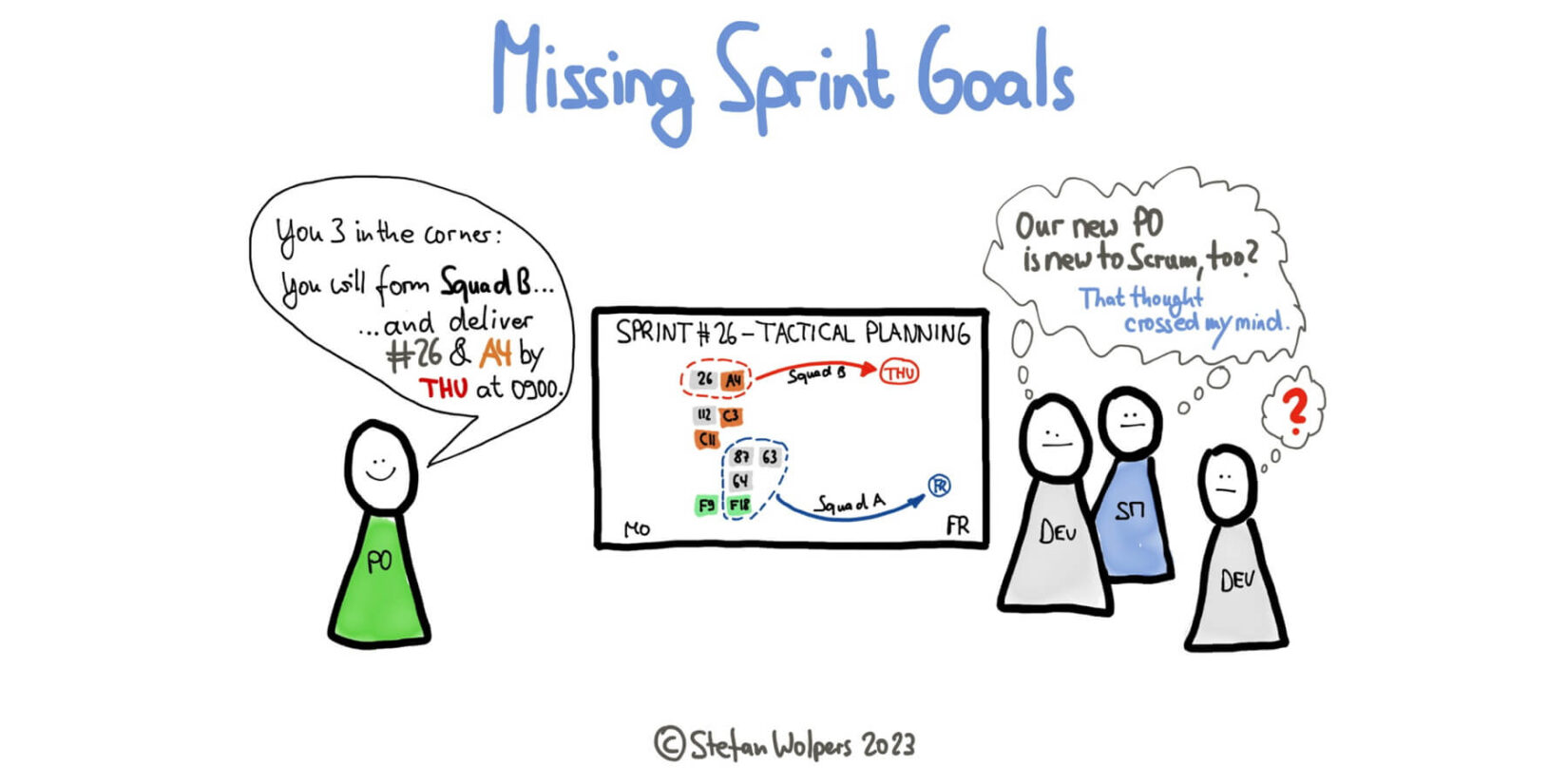TL; DR: How To Spot Successful Scrum Masters In this article, I unravel the secrets of what makes a Scrum Master not just good but amazingly outstanding. From regularly achieving Sprint Goals, delivering value to customers, and building stakeholder...
TL; DR: How To Spot Successful Scrum Masters
In this article, I unravel the secrets of what makes a Scrum Master not just good but amazingly outstanding. From regularly achieving Sprint Goals, delivering value to customers, and building stakeholder rapport easily, discover the traits that set apart successful Scrum Masters.
Moreover, we also shed light on the pitfalls to avoid if you want to keep the respect of your teammates and probably your job.

? Preorder the Scrum Anti-Patterns Guide book now for delivery in January 2024!
?? Exclusively on my Substack Newsletter: The Importance of Quality for Agility — An Excerpt from the Scrum Anti-Patterns Guide (7).
? The most popular discussion on LinkedIn last week was: Are You Planning to Hire a New #ScrumMaster? I crafted a powerful set of 10 interview questions. ?
?? Zur deutschsprachigen Version des Artikels: Erfolgreiche Scrum Master.
? Shall I notify you about articles like this one? Awesome! You can sign up here for the ‘Food for Agile Thought’ newsletter and join 49,000-plus subscribers.
? Join Stefan in one of his upcoming Professional Scrum training classes!

? Join 600-plus peers and help create the next edition of the Scrum Master Salary Report!
The Successful Scrum Masters
Evaluating a Scrum Master’s effectiveness involves several major indicators:
Sprint Goal Achievement Consistency: Assessing the Scrum Master’s impact can be done by observing how consistently the team accomplishes the Sprint Goals, contributing to the overarching Product Goal. As set for each Sprint, regularly achieving these goals suggests the Scrum Master’s effectiveness in creating an environment where Product Backlog management and Sprint Planning work well, including all team members. This consistency in reaching Sprint Goals, in line with the Scrum Guide’s emphasis, is a crucial indicator of the team’s progress and the Scrum Master’s adeptness in guiding them along the path to fulfilling the current Product Goal. Quality of Increments: Evaluating the quality and consistency of the Increments produced by the team is another vital indicator of a Scrum Master’s effectiveness. In Scrum, creating high-quality increments that meet the Definition of Done and customer expectations reflects the team’s collective effort and the Scrum Master’s success in promoting an environment aligned with Agile principles. This approach involves ensuring fewer defects, positive user feedback, and alignment with customer requirements, indicating that the team is collaboratively delivering working software effectively and consistently. Stakeholder Feedback: Collecting feedback from stakeholders outside the Scrum team, such as users, customers, and internal business partners, offers valuable insights into the Scrum Master’s performance. Positive stakeholder feedback regarding effective communication, educational efforts, progress transparency, and satisfaction with outcomes reflects the Scrum Master’s successful facilitation of Agile principles. This emphasis on stakeholder collaboration demonstrates the Scrum Master’s role in ensuring that the team’s work aligns with broader organizational goals and external user needs. Measuring Value Creation: In recognizing the contributions of Scrum Masters, a comprehensive approach would be to evaluate their impact on key outcome-based metrics that focus on creating value for customers and contributing to the organization’s bottom line. This approach includes assessing customer satisfaction rates and determining how effectively the Scrum Master guides the team to meet customer needs and expectations. Also important is measuring business impact and ROI, reflecting the Scrum Master’s role in supporting the Product Owner’s efforts to align team efforts with strategic business goals. User engagement metrics provide insights into the usability and appeal of the product. In contrast, the quality of product/service metrics like defect rates indicate the team’s commitment to excellence under the Scrum Master’s leadership. Finally, the Scrum Master’s encouragement of innovation and continuous improvement within the team ensures ongoing value creation, making these metrics integral to understanding their genuine contribution to the organization. Impediment Resolution and Innovation: Evaluating a Scrum Master’s effectiveness in resolving impediments and fostering innovation and process improvements is also crucial. Their ability to promptly and effectively address obstacles, be they technical, process-related, or interpersonal, is essential for sustaining team momentum. Simultaneously, their success in encouraging the team to adopt innovative practices and continuously refine processes reflects adherence to the Agile Manifesto’s principle of continuous improvement. This dual focus ensures the Scrum Master contributes significantly to the team’s overall success and adaptability. Improvements: Evaluating the tangible improvements made from action items identified in Retrospectives is another indicator of a Scrum Master’s effectiveness. This part involves looking at how well the team implements changes and improvements in their processes and the outcomes of these changes. Continuous improvement is a core Agile principle, and effective Retrospectives are crucial for this process. Team Health: Regular team surveys can provide insights into the Scrum Master’s influence on team morale and collaboration. Questions can focus — among other areas — on the team’s perception of the Scrum Master’s leadership, communication skills, and effectiveness in removing impediments. High levels of team satisfaction often correlate with successfully living Scrum principles, aligning with the Agile Manifesto’s emphasis on motivated individuals.
Cannot see the form?
Please click here.
Attributes of Successful Scrum Masters
Now, let’s shift our focus and delve into the attributes that distinguish a successful Scrum Master:
Facilitation Skills: Successful Scrum Masters are adept at facilitating team meetings and Scrum events, ensuring they are focused and productive. They create an environment where team members feel comfortable sharing ideas and concerns, fostering open communication. This skill is essential in realizing the Agile Manifesto’s value of “Individuals and interactions over processes and tools.” They guide the team in defining objectives, making decisions, and solving problems efficiently, ensuring that events run effectively. Successful Scrum Masters also educate their teammates in applying basic facilitation techniques so they can cover for them. Conflict Resolution: Conflict is inevitable in any team setting. Successful Scrum Masters are skilled in conflict resolution, fostering a healthy, collaborative environment. They address issues promptly and constructively, ensuring that conflicts do not hinder team progress and adhering to Scrum values. This ability is essential for maintaining Scrum’s collaborative spirit. Servant Leadership: The Scrum Guide 2020 emphasizes the role of the Scrum Master as a “true leader.” Successful Scrum Masters prioritize their team’s and organization’s needs over their personal agenda. They empower team members, encourage autonomy, and help remove obstacles. This approach also aligns with the Agile Manifesto’s principles of building projects around motivated individuals, providing them with the environment and support they need, and trusting them to get the job done. Empathy and Emotional Intelligence: High emotional intelligence enables Scrum Masters to understand and manage their emotions and support their team members accordingly. They are empathetic and capable of sensing team dynamics and addressing underlying issues. This emotional understanding fosters a trusting and psychologically safe environment, which is crucial for effective collaboration and communication. Continuous Improvement Focus: Effective Scrum Masters constantly seek opportunities for process improvement, embodying the Agile principle of reflecting on becoming more effective. They encourage the team to embrace change and continuously improve their practices, workflows, and behaviors, leading to increased productivity and product quality. Transparency Advocate: Promoting transparency in all aspects of work is crucial. Successful Scrum Masters ensure the team’s work, challenges, and successes are visible to all stakeholders. This focus aligns with the Scrum Guide’s emphasis on openness and honesty and supports the Agile Manifesto’s value of customer collaboration over contract negotiation. Technical Understanding: While they don’t need to be technical experts, successful Scrum Masters have a good grasp of the technical aspects of projects. This understanding helps them facilitate technical discussions, comprehend challenges faced by the team, and assist in removing technical impediments. It is beneficial that Scrum Masters have sufficient knowledge of the domain to be effective in their roles.Attributes of Unsuccessful Scrum Masters
Finally, we need to address traits of failing Scrum Masters, for example:
Poor Facilitation: Ineffective facilitation of meetings and Scrum events can lead to disorganization and wasted time. Unsuccessful Scrum Masters might struggle to keep meetings on track, fail to engage all team members, or be unable to achieve meeting objectives, which goes against the idea of effective interactions. Directive Approach: A command-and-control approach contradicts the Scrum Master’s role as a servant leader. Unsuccessful Scrum Masters who dictate rather than guide their teams impede the team’s ability to self-organize and innovate. Lack of Engagement: Unsuccessful Scrum Masters often lack engagement with their teams. They may fail to understand team dynamics or be unaware of the challenges faced by team members. This detachment leads to ineffectiveness and a lack of alignment with Scrum values, undermining team morale and productivity. Inadequate Conflict Management: Failing to manage conflicts effectively can create a toxic team environment. Unsuccessful Scrum Masters who avoid addressing conflicts, sweep them under the rug, or handle them poorly disrupt team collaboration and communication, essential elements of successful Scrum teams. Resistance to Change: An inability to adapt to changes or incorporate feedback is detrimental in Agile environments. Unsuccessful Scrum Masters who resist change and act dogmatically hinder the team’s progress and go against the Agile principle of welcoming changing requirements, even late in development. Ignoring Technical Aspects: A lack of understanding of the technical aspects of projects and products can prevent Scrum Masters from effectively removing impediments or facilitating technical discussions. This gap can lead to delays and misunderstandings, diminishing the team’s success potential.If you like to learn more about Scrum Master anti-patterns, delve into the following article: Scrum Master Anti-Patterns — 20 Signs Your Scrum Master Needs Help.
Food for Thought
Consider the following questions to help your teams and your organization to have successful Scrum Masters and embrace agility fully:
Considering the increasing pressure on Scrum Masters to demonstrate their direct contribution to organizational success, what innovative strategies can they employ to showcase their value beyond traditional agile metrics? How can Scrum Masters evolve their role to become indispensable in organizations skeptical about the tangible benefits of agile practices, especially in sectors where Agile is not yet the norm? Considering the rapid advancements in AI and automation, how can Scrum Masters leverage these technologies to improve their effectiveness while maintaining agile principles?Successful Scrum Masters — Conclusion
The role of a Scrum Master transcends mere process facilitation; it’s about nurturing an environment where Agile principles thrive. Successful Scrum Masters blend skills like effective facilitation, servant leadership, and conflict resolution with deep empathy and a focus on continuous improvement. Conversely, recognizing the traits of unsuccessful Scrum Masters is equally vital for course correction and maintaining integrity. This article not only sheds light on what makes a Scrum Master successful but also invites readers to ponder the evolving dynamics of leadership in the face of new challenges, technological advancements, and economic hardship.
What attributes of Successful Scrum Masters have you observed? Please share your experience in the comments.
Pre-Order the Scrum Anti-Patterns Guide Book on Amazon Now!
PS: The Scrum Anti-Patterns Guide book is now available for pre-order: Check out US, UK, and DE. Click the banner to be directed to your local Amazon store. (Handled by Genius Link; includes an affiliate link at no cost to you.)

Successful Scrum Masters — Related Articles
Scrum Master Anti-Patterns — 20 Signs Your Scrum Master Needs Help
22 Scrum Master Anti-Patterns from Job Ads
The Scrum Master Salary Report 2023
Lipstick Agile — 15 Signs You Probably Need a New Job or to Roll-up Your Proverbial Sleeves
Download the Scrum Anti-Patterns Guide for free
? Scrum Training Classes, Workshops, and Events
Learn more about successful Scrum Masters with our Scrum training classes, workshops, and events. You can secure your seat directly by following the corresponding link in the table below:
See all upcoming classes here.

You can book your seat for the training directly by following the corresponding links to the ticket shop. If the procurement process of your organization requires a different purchasing process, please contact Berlin Product People GmbH directly.
? Do Not Miss Out and Learn more about Successful Scrum Masters — Join the 19,000-plus Strong ‘Hands-on Agile’ Slack Community
I invite you to join the “Hands-on Agile” Slack Community and enjoy the benefits of a fast-growing, vibrant community of agile practitioners from around the world.

If you like to join all you have to do now is provide your credentials via this Google form, and I will sign you up. By the way, it’s free.
Support your team’s efforts with Successful Scrum Masters by pointing to the free Scrum Anti-Patterns Guide:

The post Successful Scrum Masters appeared first on Age-of-Product.com.













